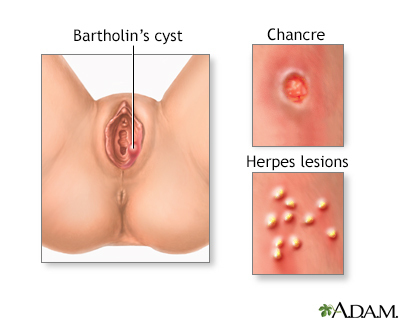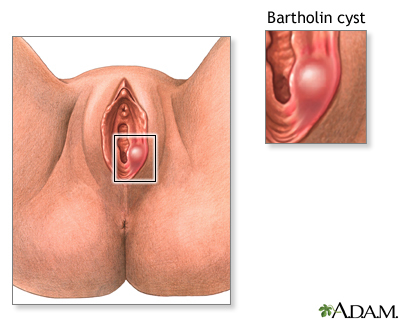Genital sores - female
Definition
Sores or lesions on the female genitalia or in the vagina may occur for many reasons.
Alternative Names
Sores on the female genitals
Considerations
Genital sores may be painful or itchy, or may produce no symptoms. Other symptoms that may be present include pain when you urinate or painful sexual intercourse. Depending on the cause, a discharge from the vagina may be present.
Causes
Infections spread through sexual contact can cause these sores:
- Herpes is a common cause of painful sores.
- Genital warts may cause painless sores.
Less common infections such as chancroid, granuloma inguinale, molluscum contagiosum, and syphilis may also cause sores.
Changes that may lead to cancer of the vulva (vulvar dysplasia) may appear as white, red, or brown patches on the vulva. These areas may itch. Skin cancers such as melanoma and basal cell and squamous cell carcinomas may also be found, but are less common.
Other common causes of genital sores include:
- Long-term (chronic) skin disorder that involves red itchy rashes (atopic dermatitis)
- Skin that becomes red, sore, or inflamed after contact with perfumes, detergents, fabric softeners, feminine sprays, ointments, creams, douches (contact dermatitis)
- Cysts or abscesses of the Bartholin or other glands
- Trauma or scratches
- Flu-type viruses that can cause genital sores or ulcers in some cases
Home Care
See a health care provider before treating yourself. Self-treatment may make it harder for the provider to find the source of the problem.
A sitz bath may help relieve itching and crusting.
If the sores are caused by a sexually transmitted infection, your sexual partner may need to be tested and treated as well. Do not have any type of sexual activity until your provider says the sores can no longer be spread to others.
When to Contact a Medical Professional
Contact your provider if you:
- Find any unexplained genital sore
- Have a change in a genital sore
- Have genital itching that does not go away with home care
- Think you might have a sexually transmitted infection
- Have pelvic pain, fever, vaginal bleeding, or other new symptoms as well as genital sores
What to Expect at Your Office Visit
Your provider will perform a physical examination. This most often includes a pelvic examination. You will be asked about your symptoms and medical history. Questions may include:
- What does the sore look like? Where is it located?
- When did you first notice it?
- Do you have more than one sore?
- Does it hurt or itch? Has it grown bigger?
- Have you ever had one before?
- How often do you have sexual activity?
- Do you have painful urination or pain during sexual intercourse?
- Do you have abnormal vaginal drainage?
The following tests may be done:
- Complete blood count (CBC)
- Blood differential
- Skin or mucosal biopsy
- Vaginal or cervical culture
- Microscopic vaginal secretion exam (wet mount)
Treatment may include medicines that you put on the skin or take by mouth. The type of medicine depends on the cause.
Gallery



References
Augenbraun MH. Genital skin and mucous membrane lesions. In: Bennett JE, Dolin R, Blaser MJ, eds. Mandell, Douglas, and Bennett's Principles and Practice of Infectious Diseases. 9th ed. Philadelphia, PA: Elsevier; 2020:chap 106.
Frumovitz M. Neoplastic diseases of the vulva and vagina. In: Gershenson DM, Lentz GM, Valea FA, Lobo RA, eds. Comprehensive Gynecology. 8th ed. Philadelphia, PA: Elsevier; 2022:chap 30.
Eckert LO, Lentz GM. Genital tract infections: vulva, vagina, cervix, toxic shock syndrome, endometritis, and salpingitis. In: Gershenson DM, Lentz GM, Valea FA, Lobo RA, eds. Comprehensive Gynecology. 8th ed. Philadelphia, PA: Elsevier; 2022:chap 23.
Link RE, Tang N. Cutaneous diseases of the external genitalia. In: Partin AW, Dmochowski RR, Kavoussi LR, Peters CA, eds. Campbell-Walsh-Wein Urology. 12th ed. Philadelphia, PA: Elsevier; 2021:chap 59.